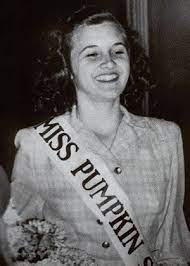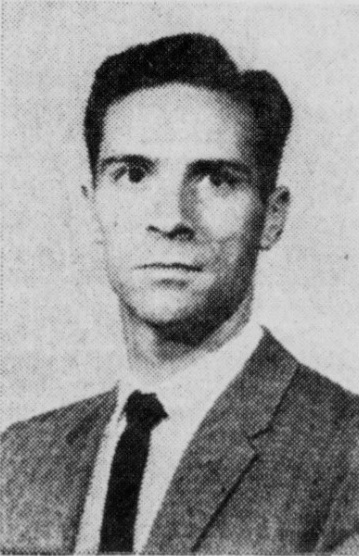Welcome To Circleville, Ohio… I Guess
Most people tend to describe Circleville, Ohio as a calm and peaceful place. For the most part, it’s just another typical small town in Ohio, located halfway between Chillicothe and Columbus. People who live in the area might tell you about a few restaurants they particularly enjoy, if you enjoy Jazz then the Ted Lewis Museum on Main Street might be for you. Some find the A. W. Marion State Park is worth the short drive toward the North-East. And from what I hear, no visit to Circleville is complete without a stop at the Wittich’s Candy Shop.
Beyond that, there’s not much that happens around Circleville, except during the third week in October when the annual Pumpkin Festival turns just about everything in town into that particular shade of Orange, bringing in people from all over the world (usually).
The fine people of Circleville wish that was all their town was known for, because underneath the surface of this peaceful small town lies an incredibly unsettling history – a two decade campaign of terror, one probable murder plus another attempted one, and an unsolved mystery that has fascinated the world since Robert Stack introduced it to us on the show Unsolved Mysteries.
The Circleville Poisoned Pen Letters, Gordon Massie, and Mary Gillespie
Nobody really knows when the residents of Circleville began getting poisoned pen letters. Most people believe that it began in the Spring of 1976 when Mary Gillespie got her first letter, but in more recent years evidence has come out stating that at least a couple of others had been getting letters for a month or two by that point – but nobody knew of the craziness that was about to come, and for various reasons few of those letters survived.


Before we go on with this story, let me explain a bit more about the letters. Some were written on lined paper, like you would see in just about any school at the time. Others were written on plain white paper while a few were on large index cards. All were written using distinctive block letters, and most came in envelopes postmarked in Columbus (which is about twenty-five miles north of Circleville). Most envelopes did not contain a return address, while on others the address was fake, or if it was real, then it was a place not associated in any way with anyone involved in the story and everyone who resided there was cleared of any possible involvement.
Eventually handmade signs made of cardboard or poster paper would begin to appear in town featuring the familiar block letters and containing similar messages. They appeared taped to walls, or storefront windows, or on objects such as Newspaper Boxes. These signs would mostly appear overnight, to this date there are no credible sources saying they personally witnessed these signs going up.
So, I can hear you asking, what did these letters say? Well, that all depends on who got the letters.
For the most part, all the letters either accused someone of doing something and asking them to stop or else they would face some sort of unspecified consequences (For example, one letter stated they had seen the 40 year old woman out with a man who was not her husband, and threatening to tell the members of her church, where she is well respected, and wondering what their reaction would be.) Other letters urged the person who got the letter to vote a particular way in the upcoming election, or else the writer would expose some secret that the person might not want to get out.
With the vast majority of the letters, it was impossible to know if whatever they were being accused of was true or not. A few times, the letters did contain things which were known at the time to be true, while others could be quickly debunked. (For example, when the letter writer says he saw someone do something immoral on a particular date, but on that date the person was hundreds of miles away visiting relatives.”
In a weird way, and depending on the circumstances, some people felt the truth was irrelevant – even though they knew the accusation to be false, there was always the possibility that someone might believe it, which could lead to negative consequences for the parties involved. (So, Sally, who is not a real person, might get a letter saying she lets her dog poo in her neighbor’s yard, and even though she knows this hasn’t happened, her neighbor might believe that it did, which could lead to some awkward situations and animosity between the suddenly now feuding neighbors.)
Mary Gillespie was a bus driver for the school district in Circleville. Gordon Massie was, in the mid to late 1970s, the school district Superintendent. In the Spring of 1977, Mary gets an anonymous letter in the mail, postmarked from Columbus, accusing her of having an affair with Gordon Massie and instructing her to call it off. The following day, she receives another one, saying pretty much the same thing but using more forceful words. And, the day after that…
Soon, it became known that Mary wasn’t the only person getting poisoned pen letters. The Sheriff’s Department would begin some sort of investigation, trying to figure out what was going on with the letters, although there was some question which laws, if any, were being broken. Some people did show their letters to the sheriff’s officers, although the majority claimed to have thrown them away. Many people said they did not take the letters seriously as the claims were far from the truth and the threats too open ended.
Even though not everybody disclosed the contents of their letters to the sheriff, it appears as if most of them in the early days dealt with some kind of sexual impropriety.
By August of that year, Mary Gillespie was still getting letters when she and her sister flew down to Florida on a vacation that had been planned before the letters even started. And it was during this trip that the story would take a drastic turn.
Ron Gillespie
By the time Mary Gillespie was vacationing in Florida, Ron Gillespie had also started getting letters. His letters also mentioned Mary’s affair with Gordon Massie and threatened him if he didn’t make his wife stop. But, on the evening of August 19th, 1977 something changed when the phone at the Gillespie household rang. Ron answered it, and after the call he indicated to the couple’s daughter that it was the letter writer. More than that – he knew who the caller was and he knew how to make it stop. Before leaving the house, he grabbed his revolver before driving off into the night.
Within a couple of short hours, Ron Gillespie would be found dead, in his truck, after having driven off the road and hitting a tree. The Pickaway County Coroner, Dr. Ray Carroll pronounced him dead at the scene, just one of several drunk driving fatalities that evening in Pickaway County.
Later on, there would be some debate over his manner of death. Some would try to claim Ron’s death was a suicide, others would say he was murdered. Semi-officially, his manner of death would be changed to unknown, but there was no further investigation at that time.
Still, we are left with many questions regarding Ronald Gillespie’s death and what happened between the time he drove off into the night and when he was found dead inside his truck. The most obvious question being … What was he doing? Where did he go? Who did he see? Sadly we can’t answer any of these questions.
The Coroner, Dr. Ray Carroll would eventually claim that blood tests he had ran did indicate that Ron had alcohol in his system at levels above the legal limit. Most people who knew Ron described him as mostly a non-drinker and said they were very surprised to hear he was drunk at the time of the crash.
Ron’s gun had one bullet missing and the gun itself had shown signs of having recently been fired. These facts were overlooked by the Sheriff’s department who called this information irrelevant.
When you put all the known information together … the letters, Ron’s phone call and telling his daughter he knew who the letter writer was, Ron grabbing the gun on his way out the door … It all calls into question the Coroner’s manner of death as revealed at the scene and the sheriff’s lack of willingness to investigate the matter.
The Next Seven Years
Over the next seven years, the vast majority of people who lived in the city of Circleville, and quite a few people who lived elsewhere in Pickaway County kept receiving letters and there was little anybody could do to make them stop. Some of the letters contained what appeared to be truthful information, while others were easily written off as false. One lady commented that she got a letter suggesting that she was physically abusing her daughter, however she and her husband were unable to have children and to the best of her memory, there had been no kids in or around her house for quite some time. Another lady received a letter claiming she was having an affair with someone from work. She admits that she had met a man from work and the two had gone out to dinner, but the letter scared her and she never tried to take the relationship any farther.
While some of the letters were like this, there was, overall, a greater number of letters written about Gordon Massie, only some of which were sent to Mary Gillespie.
In 1979, Clara and Gordon Massie got divorced. Shortly after, in a plot twist a lot of people saw coming a mile away – Gordon Massie began dating Mary Gillespie. After years of denying an affair, it came as no surprise to some people that the two would now, publicly, start being seen around town in each other’s company. Yet, both Mary and Gordon denied seeing each other prior to Gordon’s divorce, let alone Ron GIllespie’s death.
And yet, the letters continued to come in, focusing on Mary’s relationship with Gordon, even though both were now, technically, single and free to mingle. I suppose that as Gordon was the superintendent of the schools where Mary worked as a bus driver, there might be a case to be made about Gordon being in a position of power over Mary, but nobody seemed to have said that, at least not in those terms.
In many ways, The Letter Writer had become the talk of the town, even though few people wanted to admit to getting a letter themselves. On several occasions The Sheriff’s Department was criticized for not doing enough to catch the letter writer, however there was only so much they could do, legally speaking. And since there was no way of knowing how many people were getting letters because they refused to hand them over to law enforcement, it was quickly becoming a no-win situation for everyone.
Mary Gillespie, however, was starting to get to the point where enough was enough. If the police were unable to make the letter writer stop, maybe there was something she could do. On a Sunday afternoon she met with several friends in her living room, including her sister, her sister’s husband – a man named Paul Freshour, and a couple of her closest friends. Together, they reviewed everything they knew about the letters, the writer, and tried to figure out who it might be. By the time evening rolled around, they had a very short list of possible suspects – they just needed to come up with a plan.
An Attempted Murder
One morning, while Mary was driving her usual bus route, she came to a rural intersection and saw one of the letter writer’s signs. This one spoke not just about her, but also contained some vile comments and threats regarding her Daughter. Slightly enraged, Mary stopped the bus on the shoulder of the road, walked a short distance and snatched the sign off the fence post it had been attached to. Much to her horror, she quickly discovered that behind the sign was a wooden box. Inside the box was a gun – the sign was part of a booby trap which, luckily for Mary, did not go off when she snatched the sign down. She collected all the various parts of the trap and as soon as she was done with her bus route, headed straight for the sheriff’s office.
After a brief investigation, the Sheriff believed he had finally caught the letter writer. Even though someone had tried to file off the shotgun’s serial number, the police were able to perform a few forensic tests on it and the serial number became legible. When they tried to trace the gun, using this serial number, it came back to one individual. And, it was someone very close to Mary Gillespie. Paul Freshour. Even though Mary’s Sister and Paul had recently been divorced, Mary and Paul had still remained friendly. The sheriff wasn’t sure why Paul would want to terrorize Mary, but the evidence pointed only to him, so Paul got arrested – not for being the letter writer, but for attempted murder.
In due time, Paul Freshour was tried, then convicted and sentenced to prison. For a few days, the town collectively exhaled a sigh of relief.
Post Conviction
Even at the time of his arrest, there have been some who felt that Paul’s arrest for the attempted murder of Mary Gillespie was an error. They did not believe he had anything to do with the booby trapped sign, nor did they believe that he was the Circleville Letter Writer. But, if there was one thing that most people could agree on, it was that if Paul Freshour was the letter writer, and if The Letter Writer was safely behind bars, that means the nightmare was over, right?
Um … no.
Even with Freshour in the prison system, where all his outbound (and inbound) mail was monitored, Pickaway County residents kept getting the poisoned pen letters. And a few signs were spotted in town. So, the question lingered – if Paul was behind the letters, how was it possible he kept sending them, and how was it possible he posted the signs. It didn’t make sense.
The official word from law enforcement was that it was possible that Freshour, somehow, was still sending letters from his jail cell. Or, it was possible he had an accomplice, which he was somehow communicating with. Urged by law enforcement (and other members of local government) the prison officials decided to take his mail and phone scrutiny to the next level. Now, all forms of communication were even more restricted, which would effectively put the situation into a whole other legal complexity. (Paul Freshour believed that since he was not convicted of being the letter writer, having extra monitoring of all his calls and emails was not fair. Eventually the courts would agree with him.)
The entire time that Paul Freshour was behind bars, he insisted he was innocent. He said he was not the letter writer. He said did not try to harm Mary Gillespie. And since Circleville residents continued to get these letters, a few of them started to believe him.
Unsolved Mysteries, With Robert Stack
In 1994, two things happened that had the potential of changing the letter writer narrative. The first is that Paul Freshour was paroled from prison and was now a free man. The second thing is that the events that took place over the previous twenty years became a segment for the hit TV Show Unsolved Mysteries (with Robert Stack).
Throughout the show’s history, many mysteries have been solved. Sometimes, this was due to people contracting the producers of the show with that one fact that led to the solution. Other times it inspired people to contact law enforcement and work with them.
While the show’s producers were expecting to be flooded with information from viewers, they were a bit shocked when they got their first letter. It came before the show was even aired. And, it seems, it was written by the Letter Writer himself. It read: FORGET CIRCLEVILLE OHIO: DO NOTHING TO HURT SHERIFF RADCLIFF: IF YOU COME TO OHIO YOU EL SICKOS WILL PAY: THE CIRCLEVILLE WRITER:”
This, of course, did not deter the show’s producers as they soon ran that segment, but they also filmed a new, brief introduction where Robert Stack introduces the mystery, but also displays the letter the show received.
Appearing on a national show like Unsolved Mysteries did have some interesting consequences. What had been, up to this point, little more than a local story, was now thrust into the national spotlight. And, years later, the case has been featured on blogs and podcasts, which has led to an amazing assortment of possible (and, dare I say it, rather impossible) solutions to the big mysteries.
By the end of the 1990s, as mysteriously as they began, the letters finally stopped. But, the mysteries do continue.
Many Mysteries
The big unsolved mystery here is who wrote the poisoned pen letters. We also want to know why? What was the writer trying to do? Did they have an agenda? Was there a vendetta of some sort, either against Mary Gillespie or Gordon Massie or someone else? Was Paul Freshour deliberately framed for the letter writing and the booby trapped sign aimed at Gillespie, or was the fact that a gun that had belonged to him a mere coincidence?
Who set up the booby trap? Were they wanting to get rid of Mary Gillespie or just scare her? What was the motive behind this?
Was Mary’s husband, Ron, murdered? If so, was he killed by the letter writer or by someone else? Again, what was the motive? If Ron wasn’t murdered, was it an accidental death or a suicide? Did the sheriff’s office, or any other similar body, try to cover Ron’s murder up and if so, why?
Above are just a few of the questions that I’m left with after recounting the basic facts of the case. Personally, I have heard more theories than I can count, trying to answer some (if not all) the above questions. Those, I will get to in Part II of The Circleville Letter Writer.




Pingback: The Circleville Mystery (Part II) - The Ohio Project